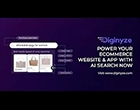
In this age where individuals seek for instant services, the online shopping landscape has become a crucial battleground for online businesses. With eCommerce sales in the U.S. projected to reach a whopping $1.3 trillion by 2025, as per Statista, it's no surprise that competition is fierce. But what separates the online stores that thrive from those that fizzle out? The answer lies in a concept called User Experience (UX).

Source: GoodFirms
Understanding UX: The Roadmap to Customer Satisfaction
Think of UX as the invisible map that guides your customers through your online store. It encompasses every interaction a customer has with your website, from the moment they land on the homepage to the final click on the "purchase" button. A well-designed UX is smooth, intuitive, and enjoyable, making the shopping journey effortless. On the other hand, a poor UX can be riddled with frustrations and roadblocks, ultimately driving customers away.
The stakes are high. A positive UX can lead to a 200-400% increase in conversions, while a negative one can contribute to a staggering 70% cart abandonment rate according to a Baymard Institute study.
Why is UX essential for your eCommerce Business?
-
Boosts Conversions: A seamless User Experience removes friction from the buying process. Customers can easily find the products they're looking for, navigate through product pages, and complete their purchases without any hiccups. This depicts that there are more website visitors turning into paying customers.
-
Reduced Cart Abandonment: Filling your shopping cart with stuff you like, only to get stuck at checkout due to a confusing process or hidden fees. That's cart abandonment in short. By streamlining your checkout and offering multiple payment options, you can significantly reduce this pain point and recover lost sales.
Read also: 6 Ways to Improve Your Shopping Cart Checkout Experience
-
Build Customer Loyalty: When customers have a positive experience shopping on your site, they're more likely to come back for more. A well-designed UX fosters trust and satisfaction, creating loyal brand advocates who sing your praises to their friends and family. In today's digital world, positive word-of-mouth marketing is invaluable.
-
Improve Search Engine Ranking: Search engines like Google prioritize websites that offer a positive user experience. By optimizing your UX with factors like fast loading times and clear navigation, you can improve your search ranking and attract more organic traffic to your store.
Crafting a Superb User Experience: Tips for eCommerce Success
Now that we know the UX essentials for eCommerce, let's explore some actionable tips to drive shopping experience on your store:
-
Navigation: Let’s say that your website's navigation is same as a well-organized department store. Customers shouldn't have to wander aimlessly, searching for the products they want. Here's how to create a navigation system that's user-friendly:
-
Intuitive Menu Structure: Organize your product categories logically. Avoid overwhelming customers with too many options. Studies show that 50% of online stores have navigation issues. Use clear and concise labels for your menu items to stand out from the crowd.
-
Search Bar Savvy: Place a prominent search bar at the top of your website. This helps customers to find specific products quickly and efficiently. Consider using AI-powered search features that utilize auto-suggest and anticipate search terms to display relevant results in real-time.
Read also: AI-Driven Search: The New Era of Search in eCommerce
-
Breadcrumb Bliss: Breadcrumbs are those little navigational pathways that show customers their current location within your website's hierarchy. They allow users to backtrack easily if needed, providing a sense of control and reducing frustration.
-
Mobile Marvel: In a world where over 50% of website traffic comes from mobile devices, one cannot afford to overlook the importance of mobile commerce. Ensure a mobile-friendly navigation experience. Responsive design is key here. Your website's navigation should adapt seamlessly to different screen sizes, providing an effortless browsing experience on smartphones and tablets.
-
-
Checkout: The checkout process can make or break a sale. Here are some best practices to create a smooth and stress-free checkout experience:
-
Guest Checkout Hero: Don't force customers to create an account during their first purchase. Offer a guest checkout option to minimize friction to expedite buying process. You can always incentivize account creation later with rewards programs or exclusive discounts.
-
Progress Bar Power: Break down the checkout process into clear steps with a progress bar. This visual indicator shows customers how far they've come and what's left to complete, keeping them motivated to finish the checkout process.
-
Form Field Focus: Nobody enjoys filling out lengthy forms, especially on a mobile device. Keep the number of form fields to a minimum, requesting only essential information like billing and shipping details. Streamline the process by allowing customers to autofill information from their saved accounts or digital wallets.
Read also: Master the Art of Seamless Checkouts with Diginyze
-
-
Multiple Payment Options: Cater to diverse customer preferences by offering a variety of payment methods. This includes credit cards, debit cards, popular digital wallets, and even buy now, pay later (BNPL) options. The more payment options you provide, the more convenient and inclusive your checkout experience becomes.
-
Visual Storytelling: High-quality product listings including images and videos are essential for eCommerce success. They allow customers to virtually inspect products, zoom in on details, and get a clear sense of what they're buying. Consider incorporating 360-degree product views and interactive features to further enhance the visual experience.
-
Content - The King: Product descriptions should be informative, engaging, and keyword-rich. Provide detailed information about the product's features, benefits, and specifications. Don't forget to include user-generated content like customer reviews and ratings. Social proof builds trust and can significantly influence buying decisions.
-
Speed is King (Literally): In the fast-paced world of online stores, patience is a rare commodity. A slow-loading website is a guaranteed conversion killer. Here are some ways to keep your website running at lightning speed:
-
Reliable Hosting: : Invest in a reputable hosting provider with fast servers and reliable uptime. A slow server can significantly impact your website's loading times and deter potential customers.
-
Image Optimization: Large, unoptimized images can significantly slow down your website. Use tools to compress image files without sacrificing quality. This ensures fast loading times and a smooth browsing experience.
-
Cache it Up: Implement browser caching to store elements of your website on visitors' devices. This reduces load times for returning customers and improves overall website performance.
-
-
Embrace the Power of Personalization: Personalization goes beyond simply addressing customers by name. Use customer data and browsing history to recommend relevant products, offer targeted promotions, and create a more tailored shopping experience. This can significantly increase customer engagement and conversion rates.
Read also: AI in eCommerce: Personalized Shopping Experiences for Higher Conversions
Continuous Optimization is the Key
UX is an ongoing journey, not a one-time destination which needs frequent optimization to keep up with the competition. Here are some additional tips to ensure your online store remains a haven for happy customers:
-
Gather Customer Feedback: : Actively solicit customer feedback through surveys, reviews, and social media interactions. Understanding customer pain points and frustrations allows you to identify areas for improvement and continuously refine your UX strategy.
-
Implement A/B Testing: A/B testing is a powerful tool that allows you to experiment with different design elements and functionalities on your website. Test out different layouts, call-to-action buttons, and product page structures to see what resonates best with your audience.
-
Stay Updated on UX Trends: The world of UX is constantly evolving. Stay informed about the latest trends and best practices. This allows you to adapt your website and keep your UX strategy fresh and innovative.
Also read: eCommerce Reimagined: Top 10 Trends You Can't Miss
Takeaway
By prioritizing User Experience, you can transform your eCommerce store from a digital maze to a customer-centric paradise. A well-designed UX fosters a seamless and enjoyable shopping experience, leading to increased conversions, customer loyalty, and ultimately, a thriving online business.
If you're looking for a powerful eCommerce platform that can help you pace-up your UX game, consider Diginyze. It offers a comprehensive suite of AI features and functionalities designed to streamline your operations, personalize the customer journey, and ultimately drive sales. With Diginyze, you can focus on building a thriving online business, while the platform takes care of the technical complexities behind a stellar UX.
Ready to Take Your eCommerce UX to the Next Level? Contact us today!
Recent Blogs
Explore latest insights and trends in technology and eCommerce.
Case Studies
Your Digital Transformation Starts Here!
Join thousands of businesses transforming with Diginyze. Sign up today and start now!


























